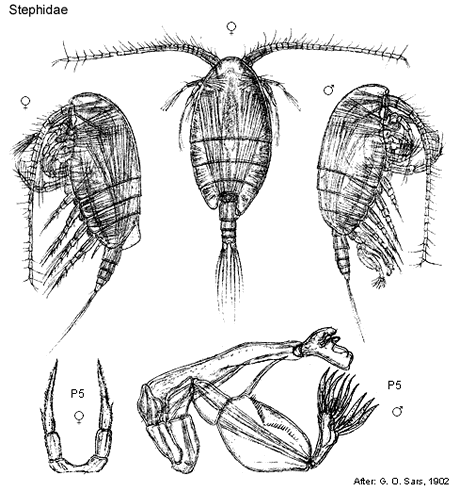 |
||||||
|
|
|
|
|
|
Calanoidea: FamiliesJ.M. Bradford-GrieveStephidae Sars, 1902
Description. Female. Anterior head in dorsal view rounded or bluntly triangular. Rostrum without filaments; rostral margin extends into 2 blunt protrusions, or not extended. Cephalosome and pedigerous somite 1 fused or partly fused, or separate; pedigerous somites 4 and 5 fused or partly fused, or separate. Posterior corners of prosome in lateral view bluntly rounded, or triangular or obtusely pointed; dorsal view symmetrical, or asymmetrical. Genital double-somite symmetrical in dorsal view, or asymmetrical in dorsal view; gonopores close together and totally covered by single genital operculum; with pair of seminal receptacles, or with one seminal receptacle; with pair of copulatory pores that are completely covered by genital operculum. Caudal rami symmetrical; seta VII located dorsally or laterally. Mouthparts. Antenna 1 with 24 free segments; ancestral segments X and XI fused. Antenna 2 exopod with 6-7 free segments; 9-12 setae; basis and endopod separate. Mandible basis with 3 setae, or with 4 setae; endopod terminal segment with 8 setae, or 10 setae. Maxilla 1 basal exite seta absent; exopod extends short of endopod distal border. Maxilla 2 coxal epipodite seta absent. Maxilliped coxal endite 2 with 3 setae. Legs. Leg 1 basis outer seta absent; endopod with 1 segment; exopod with 3 segments; exopod segment 1 without outer distal spine; exopod segment 3 with 3 inner setae. Leg 2 endopod with 2 segments; exopod with 3 segments; exopod segment 3 with 3 outer spines. Leg 3 basis outer distal spine absent; endopod segment 3 with 5 setae. Legs 3 and 4 endopod with 3 segments; exopod with 3 segments; exopod segment 3 with 3 outer spines; exopod segment 3 with 4 inner setae. Leg 4 endopod segment 3 with 5 setae. Legs 2-4 surfaces weakly spinulose, or naked; terminal spine with outer border serrated. Leg 5 present; very dissimilar from legs 2-4; coxa inner border without seta; uniramous, symmetrical or asymmetrical, coxae and intercoxal sclerite fused, basis separate from or fused to 1-segmented exopod that is tapering and usually variously ornamented with setae, spines and teeth. Mode of life. Benthopelagic, in oceanic waters or in coastal waters. Distribution on sea floor. Less than 100 m, or 100-200 m. Generic composition. This family contains two the genera: Parastephos Sars, 1902; Stephos Scott, 1892.
(Variant) Male (sexually dimorphic characters). Description. Male. Pedigerous somites 4 and 5 fused or partly fused. Posterior corners of prosome in lateral view bluntly rounded; dorsal view symmetrical. Mouthparts. Mouthparts well-developed. Antenna 1 similar, neither geniculate. Maxilliped endopod segments 5 and 6 with outer setae normal. Legs. Right leg 5 uniramous; exopod 2-segmented, segment 1 elongate unarmed but may have distal process, segment 2 either: comprising 2 processes set at right angles, or with a proximal process, or is simple and spiniform. Left leg 5 uniramous; exopod 3-segmented, segment 1 short unarmed, segment 2 often robust unarmed or well ornamented with spinules or spiniform processes distally along inner margin, segment 3 complex with 2-9 elongate, usually articulated appendages with additional hairs and spines, or segment 3 is plain, bifurcate and processes not articulated.
Cite this publication as: 'Bradford-Grieve, J.M. (2002 onwards). Calanoida: families. Version 1: 2 October 2002. https://crustacea.net'. |
|
|
|
|
|
|
|
|
|
Copyright © Australian Museum, 2002 - 2003
Australian Museum website
